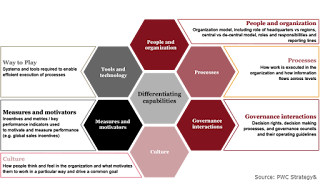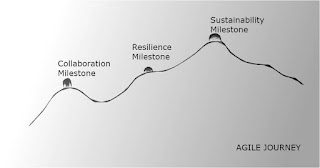The Collaboration Milestone
The collaboration milestone is an operating team level objective that transitions the team to agile and focuses on delivering two primary objectives - time to market and customer value. The collaboration milestone is delivered in three stages - Explore, Adapt and Engage.
The Explore stage is an introductory stage to familiarize team members with Agile concepts. It starts at where they are and builds out the advantages of agile over any of the practices in vogue in the organization at that point in time. And it is instructive to start all agile journeys with Kanban and the premise "start with what you know".
In the Adapt stage, the teams adopt a suitable agile methodology. This may well be Kanban itself, or it could be Scrum. Some teams with extremely short and integrated development cycles per requirement - like in the case of mobile app development - can opt to initiate a roadmap to DevOps. Some may find their processes best adapted to a Hybrid methodology like Scrumban.
Till this point, no Agile tool is selected. Teams are encouraged to develop their own tools using simple shareable spreadsheets and using inbuilt functions such as those available in Microsoft Excel or Google Sheets.
Once each team adopts a suitable Agile methodology, the requirements for a formal Agile tool is collected for software evaluation and selection. Usually this is a fairly straightforward choice with multiple vendors providing a range of solutions that to the untrained eye, appear to be offering identical features and functions. The challenge lies in really understanding and internalizing concepts (Explore-Adapt) before going for software evaluation and selection. The most popular vendors are:
- Atlassian
- Pivotal
- Microsoft
- VersionOne
- AxoSoft
- Capterra
- PlanBox
- Active Collab
- Agilo
- SprintGround
- TargetProcess
- Assembla
Here is a suggested way to evaluate Agile software tools.
The Cynefin framework provides a great governing framework to explain what is being attempted at each stage of the transition. Starting with a blank "anything is possible" spreadsheet, the teams begin to increasingly constrain requirements by clarifying and adding requirement attributes. This is represented by the anti-clockwise "restraining cycle" in the Cynefin framework.
The converse transition of process center-of-gravity happens during the Resilience phase. During this phase, process capabilities are enhanced to release constraints and revert its center-of-gravity to the boundary between complicated (knowable) and complex as shown below. A further explanation of this will be taken up in a later blog.
Once the software is evaluated and selected, it is implemented in the organization and all teams move to the agile software tool. Processes are stabilized over a period of time.
Planning for the next phase - Resilience - can commence during the Engage stage of the Collaboration Phase.
Do note that the mechanics of specific Agile methodologies are not in the scope of this blog and is not part of the consulting practice. The consulting practice thus deals primarily with the Concepts and Change Management aspects of the agile transition. Team level training on the mechanics of the agile methodology adopted is delivered by suitable third parties during the latter stabilization period of the Engage Phase and prior to the start of the Resilience phase of the transformation program.








Comments
Post a Comment